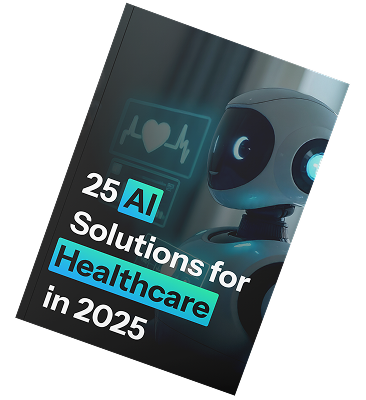Cloud Computing in Healthcare | Benefits, Applications, and Future Trends
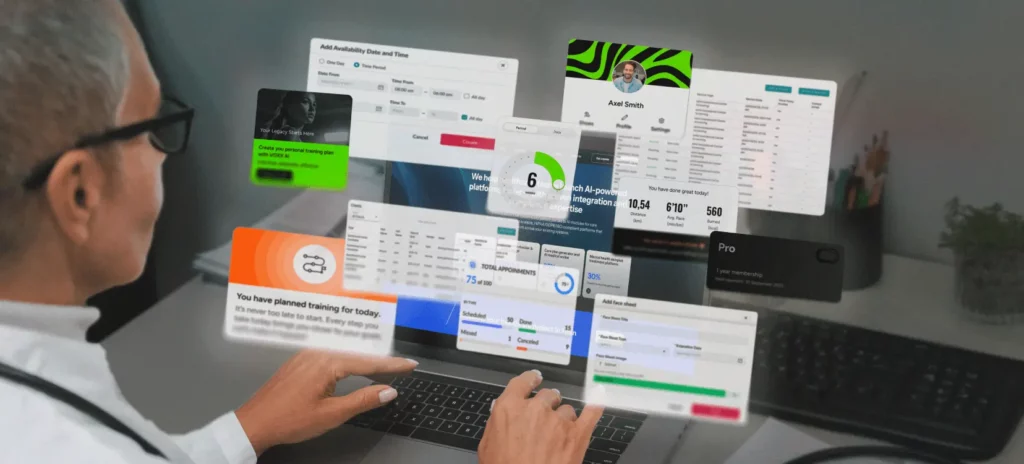
Cloud computing in healthcare has exploded, with projections showing it will hit $89.4 billion by 2027. The COVID-19 pandemic pushed healthcare’s cloud spending up by 35% in early 2020. This surge reshaped the digital world across the industry.
Cloud computing in healthcare brings major advantages—cheaper pay-as-you-go options and easier access to patient data. The technology helps medical professionals work better together and powers AI and machine learning tools that streamline operations and lead to better patient care.
In our blog post, we’ll cover:
- What’s cloud computing in healthcare: its role, types, and deployment models
- Key benefits and risks of cloud computing deployment for healthcare industry
- 7 examples of cloud computing technology application
- The future of cloud computing in healthcare
- How Riseapps can help with custom healthcare app development
What is Cloud Computing in Healthcare?
Cloud computing brings computing services to healthcare through the Internet. Organizations can access data storage, servers, databases, networking, and software without owning physical infrastructure.
Medical organizations have embraced this technology as they generate more data and look for cost-effective, expandable solutions.
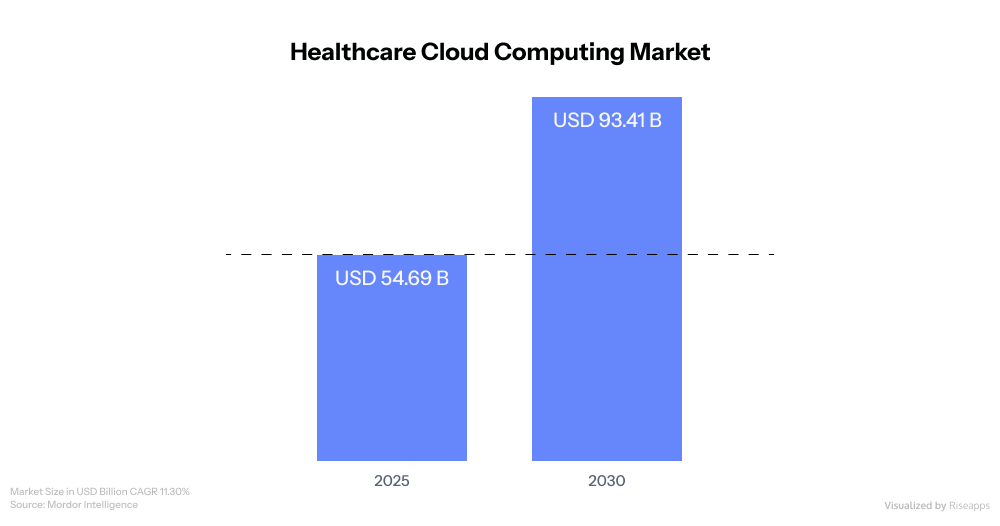
Cloud computing in healthcare enables patients to access medical data, lab test results, and physicians’ notes in real time, empowering them to better manage their health.
Additionally, cloud technology facilitates seamless information sharing among healthcare providers, further enhancing patient safety.
How Cloud Computing is Different From Traditional On-premise Systems
Cloud and on-premise solutions in healthcare differ mainly in resource management and economic models. Traditional IT requires organizations to buy, install, manage, and maintain hardware and software in their facilities.
Cloud providers own and manage these assets, while healthcare organizations access them through internet subscriptions or pay-as-you-go models.
Traditional on-premise solutions need substantial upfront capital and dedicated IT staff. Cloud models eliminate these expenses by removing equipment purchases and large in-house IT teams.
Cloud systems offer several advantages over traditional approaches in data management:
- Improved system reliability and recovery,
- Better scalability and resources adjustment based on changing needs,
- Better accessibility to health information from any location with internet connectivity,
- Reduced maintenance burden that lets healthcare IT staff focus on strategic initiatives.
Most healthcare organizations use a hybrid approach that combines on-premise and cloud systems based on workload requirements and security needs.
Providers must evaluate storage needs, computational requirements, data sensitivity, and regulatory compliance when choosing between cloud and on-premise options.
Types of Cloud Computing in Healthcare
Healthcare cloud computing works through three main service models that offer different levels of control and management:
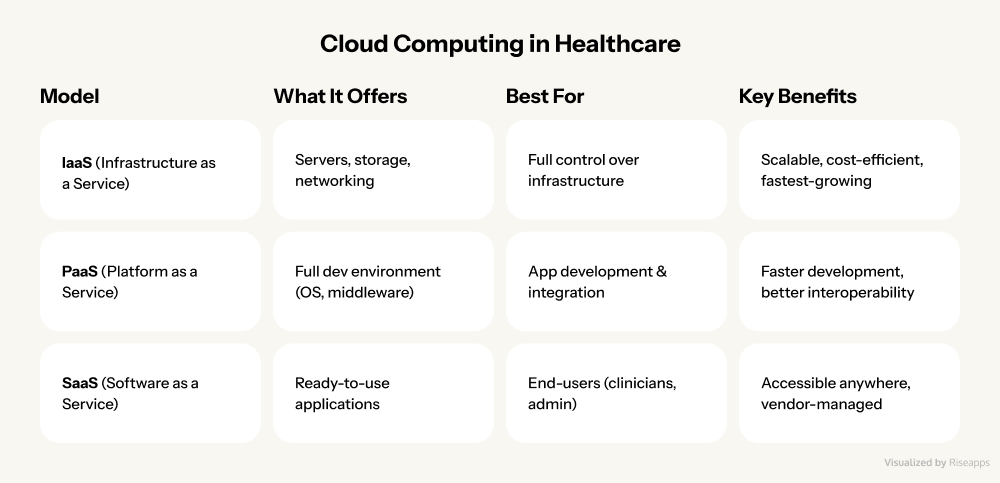
Infrastructure as a Service (IaaS)
Infrastructure as a Service (IaaS) gives on-demand access to cloud-hosted computing infrastructure:
- servers,
- storage capacity,
- networking resources.
Medical organizations can set up these resources like on-premises hardware without managing physical servers. IaaS provides direct access to cloud servers and storage, offering more administrative control than other models.
Research shows IaaS as the fastest growing cloud service in healthcare with a projected CAGR of 32 percent by 2027.
Platform as a Service (PaaS)
Platform as a Service (PaaS) manages all hardware and software resources needed for healthcare application development through the cloud.
This model handles the complete environment, including servers, operating systems, and middleware. Healthcare organizations prefer PaaS because it offers better interoperability. Applications can be developed faster with on-demand scalability.
Software as a Service (SaaS)
Software as a Service (SaaS) offers complete, ready-to-use applications through web browsers. Vendors manage everything from infrastructure to applications, including updates, bug fixes, and maintenance.
Through SaaS products, healthcare practitioners can access medical software from any location with internet connectivity.
Cloud Deployment Models in Healthcare
Healthcare organizations use multiple cloud deployment models based on their technical and regulatory needs. The three main models are public, private, and hybrid cloud, with a growing trend of multi-cloud strategies.
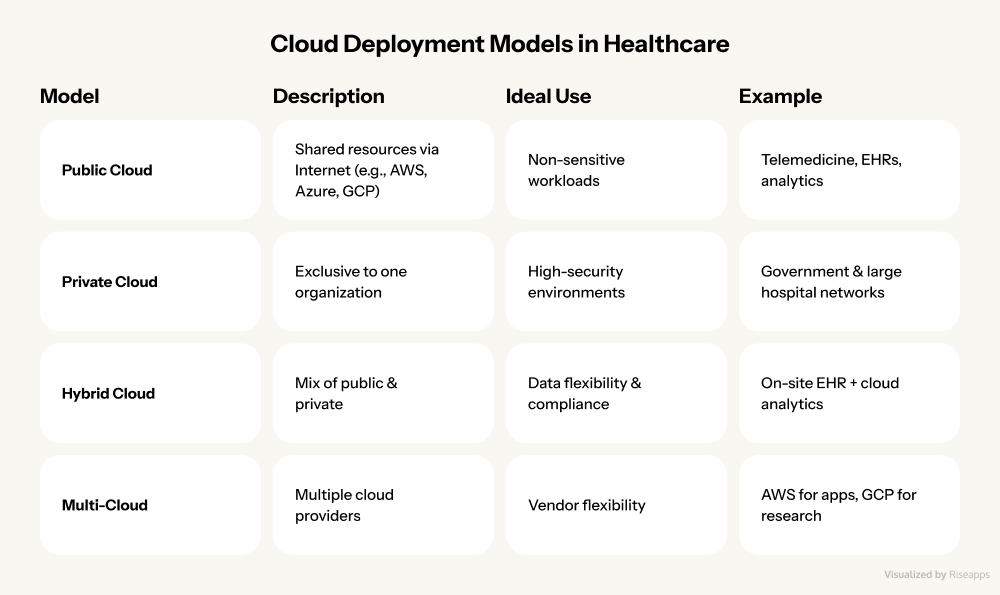
Public Cloud
In a public cloud, resources (compute, storage, applications) are hosted and operated by a third-party provider and delivered over the Internet.
All the hardware, software, and network infrastructure belong to the cloud vendor, and you can tap into virtually unlimited resources on demand.
For example, in a public cloud deployment, you share the same hardware, storage, and network devices with other organizations and pay only for what you use.
Public clouds (e.g., AWS, Microsoft Azure, Google Cloud) are highly scalable and cost-effective. They are often used to run:
- Electronic health records (EHR) systems,
- Data analytics platforms,
- Telemedicine apps,
- Other non-sensitive workloads.

We at Riseapps have been building EHR and EMR software since 2016, and therefore, we want to share our experience of creating such systems.
Delve into critical features tailored for medical practices and hospitals and outline compliance nuances crucial for successful EMR and electronic health records system development.
Private Cloud
A private cloud is a cloud infrastructure used by a single organization. It can be on-premises (hosted in the hospital’s data center) or operated by a dedicated third-party for that organization.
The hardware and software are dedicated solely to one hospital or healthcare system in a private cloud.
Private clouds are often used by:
- large hospital networks,
- research institutes,
- government healthcare bodies.
For instance, government health agencies and large health systems may use private clouds to host sensitive data or high-performance applications that require dedicated hardware.
Hybrid Cloud
A hybrid cloud combines an on-premises (private) cloud or data center with one or more public clouds. This model lets workloads and data move between the two environments as needed.
For example, less-sensitive workloads (or overflow capacity) can run in the public cloud, while critical or regulated data remains on-site or in a private cloud.
Microsoft defines a hybrid cloud as computing that “combines on‑premises infrastructure or a private cloud with a public cloud,” allowing data and apps to move between them.
Healthcare organizations often use hybrid cloud to meet data sovereignty rules and address latency or bandwidth constraints.
For example, patient data requiring low-latency access might reside in a local data center, while large-scale analytics of de-identified data can run in the public cloud.
Multi-Cloud
A multi-cloud in healthcare strategy simultaneously uses two or more cloud providers (often all public clouds).
For instance, a health system might use AWS for some applications and Azure or GCP for others, depending on specialized services.
This approach helps avoid vendor lock-in and lets organizations pick the best tool for each job.
For example, large academic medical centers often engage multiple vendors: Cleveland Clinic, for instance, has worked with both AWS and Google Cloud for different services.
Many are moving to hybrid/multi-cloud models to balance flexibility with security and compliance needs, keeping PHI in a secure private cloud while running analytics or consumer apps in public clouds.
9 Benefits of Cloud Computing in Healthcare
Cloud computing gives healthcare organizations major advantages that go beyond simple technical improvements.
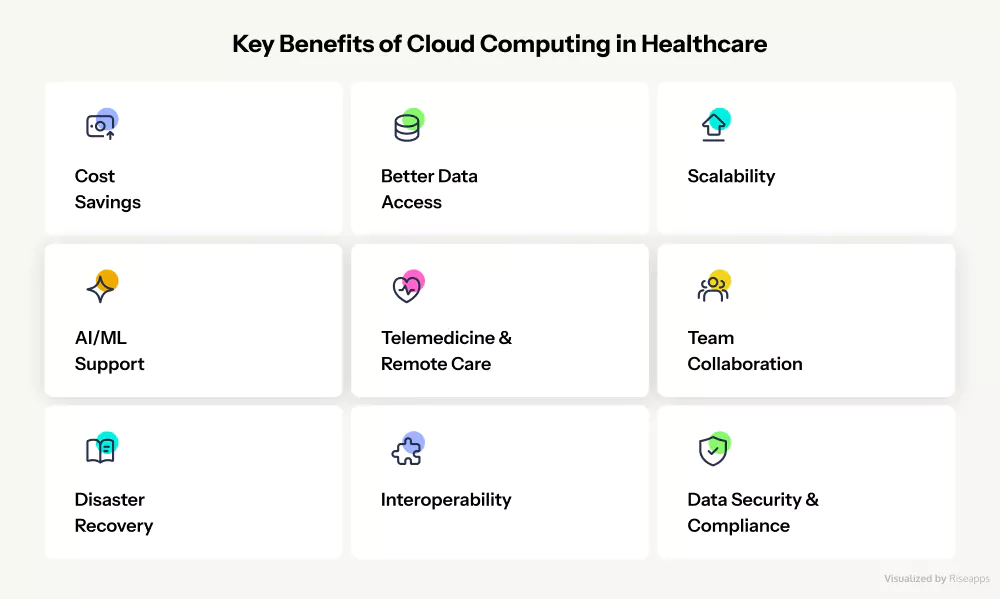
The technology creates opportunities to boost innovation and efficiency in various healthcare areas, from financial benefits to better clinical capabilities.
Cost Savings Through Pay-as-you-Go Models
One of healthcare cloud computing’s biggest advantages is its financial effect. With cloud technology, healthcare organizations can move from expensive upfront investments to variable-cost models.
Research shows that cloud technology in healthcare can lower costs by up to 30% compared to traditional systems.
These savings come mainly from eliminating hardware purchases and related maintenance and labor costs.
The cloud model changes cost structures in several ways:
- No need to buy physical hardware,
- You pay only for what you use,
- Less need for specialized IT staff to run systems,
- Resources can grow or shrink based on needs without big investments
Cloud computing in healthcare solutions also free up physical space in healthcare facilities. Moving IT systems off-site lets organizations use more space for patient care instead of server rooms.
Improved Data Accessibility for Providers and Patients
Cloud computing platforms break down location barriers, and healthcare providers can access patient data live, regardless of physical location.
Care delivery happens faster because traditional storage limits no longer delay treatment decisions.
Doctors can quickly:
- Share and access vital information in the cloud with electronic medical records (EMRs).
- Coordinate care using the patient’s complete history.
Patients can:
- Access their medical information, lab results, and physician notes.
- Take a more active role in managing their health.
Scalability for Growing Data and User Demands
Healthcare organizations deal with constantly changing data volumes and user needs, especially during health emergencies. Cloud infrastructure expands or shrinks easily based on demand without significant delays or costs.
A state health department learned this lesson during the pandemic when its system couldn’t handle increased access. “We ended up having to move it to the cloud to solve that issue,” said Rachelle Boulton from Utah’s Department of Health and Human Services.
This expandable solution works great for managing growing electronic health record systems.
Support for AI and Machine Learning in Diagnostics
Cloud computing delivers the computing power to analyze large healthcare datasets through AI and machine learning.
These technologies help healthcare systems achieve what experts call the “quadruple aim” by standardizing precision diagnostics and therapeutics.
Healthcare organizations can adopt cutting-edge technology without building AI platforms themselves.
For example, Philips HealthSuite leverages AWS’s IoT and machine learning services to rapidly deploy new connected health solutions.
AI systems with cloud computing infrastructure support:
- Precision diagnostics (including diabetic retinopathy detection and radiotherapy planning),
- Automated analysis of high-resolution medical images,
- Predictive analytics to identify patient risks and treatment recommendations,
- Natural language processing that automates administrative documentation tasks.
Enhanced Telemedicine and Remote Care Delivery
Cloud-based telehealth platforms enable live virtual consultations, remote diagnostics, and ongoing monitoring of chronic conditions. This became crucial during COVID-19.
Cloud computing merges with wearable health devices, too. Patient data from smartwatches and glucose monitors syncs to give physicians current information.
AI chatbots working with wearable devices are a great way to get insights for patients and caregivers to improve behavior, sleep, and general wellness.
Our client, a US-based healthcare provider specializing in chronic and at-home dementia care, partnered with Riseapps to integrate AI into their existing platform.
To allow this healthcare organization to provide personalized, round-the-clock patient care, Riseapps implemented a 24/7 digital AI assistant, intelligent alerts, and AI-based recommendations to enable caregivers to proactively manage critical care events and reduce their burnout.
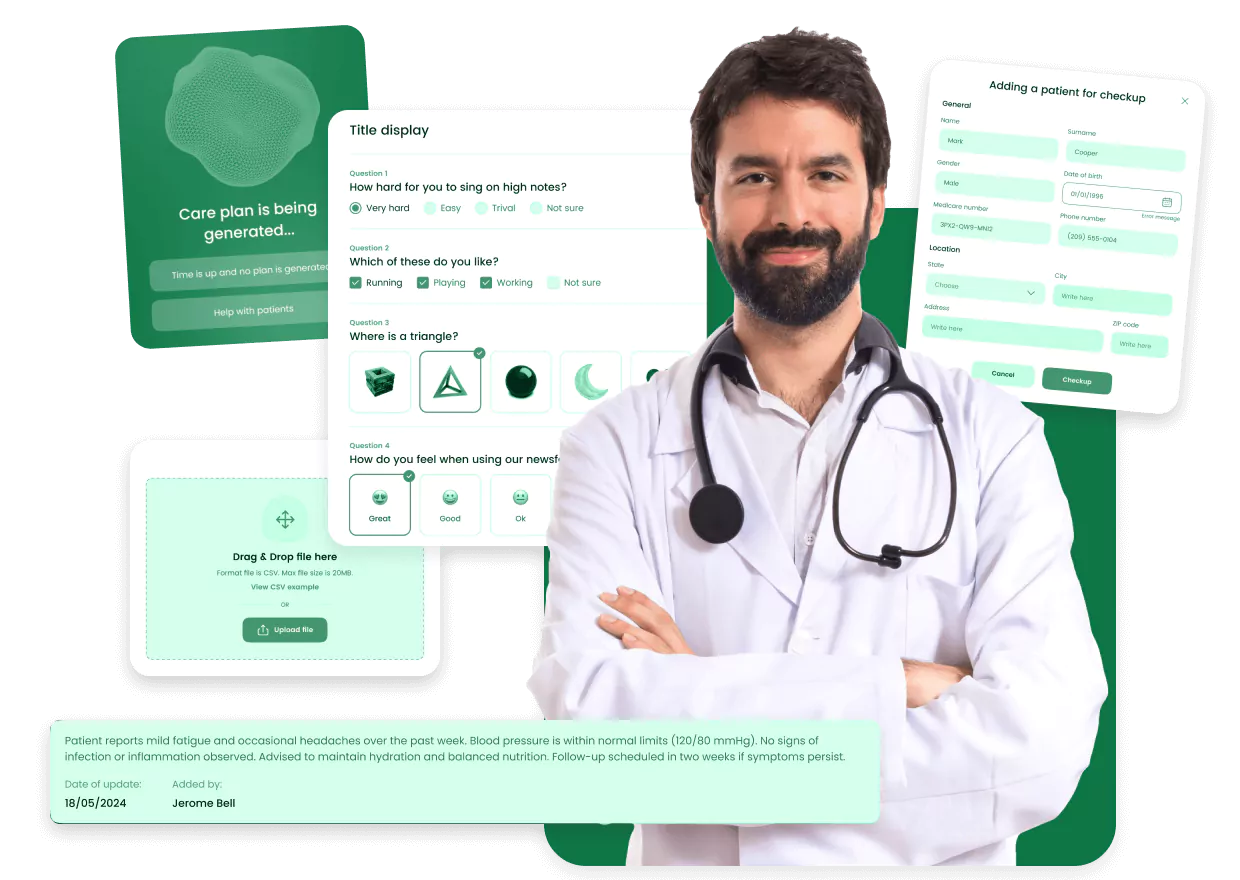
Better Collaboration Across Healthcare Teams
Cloud computing platforms help healthcare providers work together smoothly, regardless of location. Physicians in different cities can:
- View, share, and update patient records together in real time,
- Transferring files or physical records without delays,
- Coordinate treatment plans via built-in secure messaging and video-conferencing tools.
This instantaneous connectivity reduces errors, accelerates decision-making, and streamlines care coordination.
For example, The American Medical Association found that 85% of physicians believe EHR systems integrated with secure cloud messaging tools help them better share patient information.
Riseapps put these benefits into practice for The Wound Pros by developing a custom, cloud-native EHR solution.
It aimed to facilitate the use of complex medical data by transferring it to a new, intuitive cloud computing platform.
The Wound Pros needed comprehensive custom EHR solutions, including a web platform for hospitals and clinics and a mobile app for medical professionals.
The functionality of the new software product was also expected to be comprehensive, covering not only the storage and management of health records but also the management of medical facilities and patient interactions.
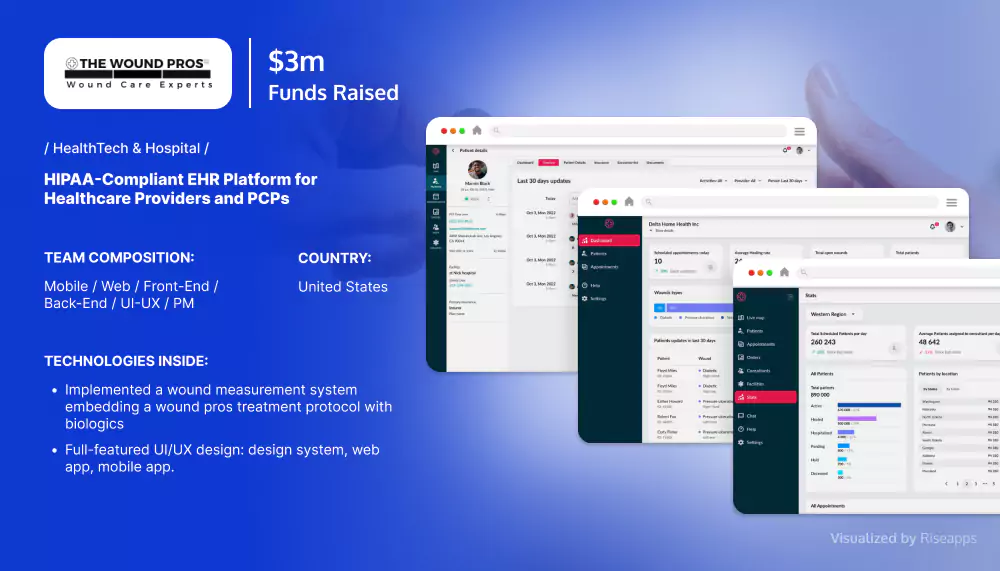
Riseapps developers have created a scalable and robust architecture for the transfer, storage, and management of PHI (Protected Health Information) and have ensured 100% HIPAA-compliance of EHR software.
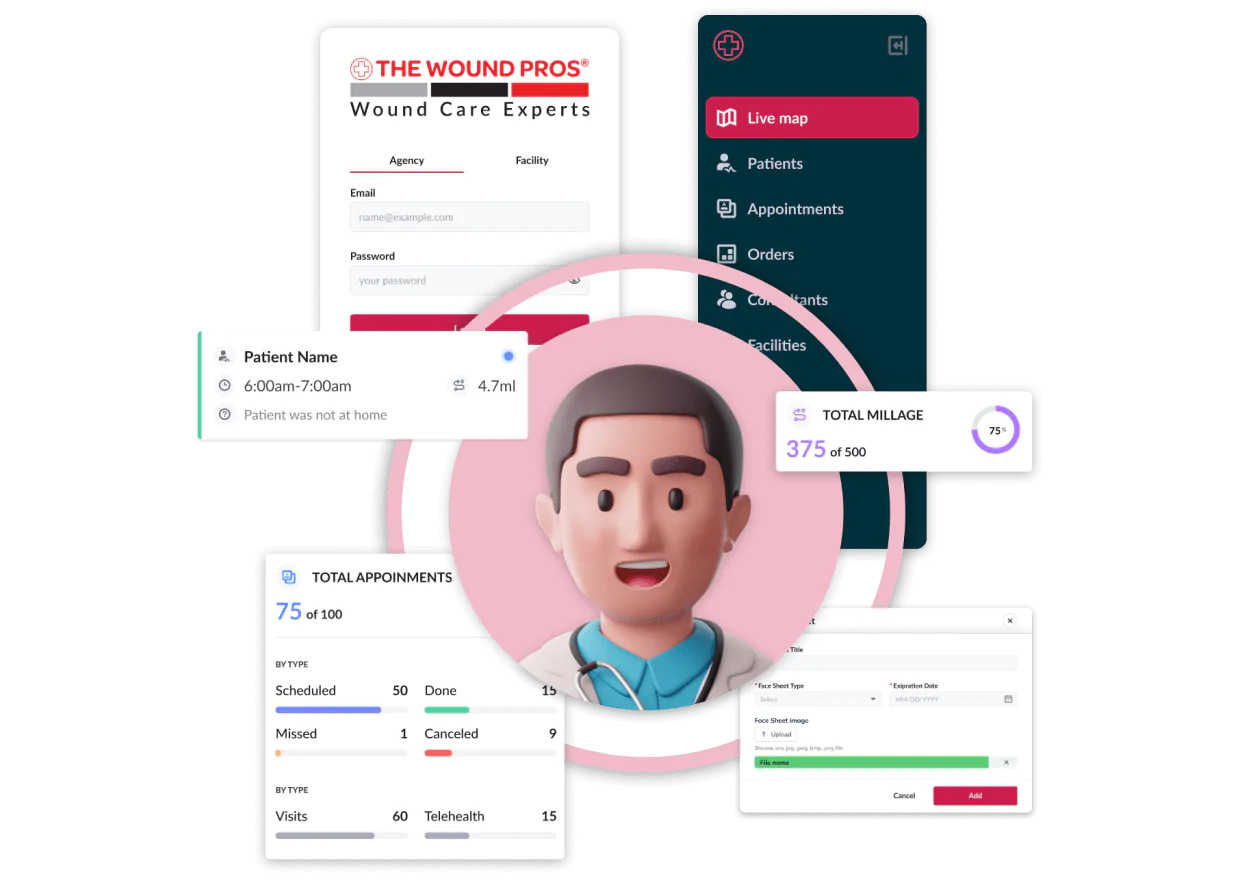
Our team developed an EHR system to meet the specific needs of The Wound Pros, including the ability to:
- track wound progress,
- generate reports for insurance billing,
- schedule appointments,
- manage medication,
- communicate securely.
Improved Disaster Recovery and Data Backup
Cloud-based disaster recovery gives healthcare organizations a crucial advantage in maintaining non-stop operations.
Public cloud data centers are geographically redundant. If problems hit one location, data stays available from other sites.
Cloud computing solutions offer automatic recovery features that cut downtime significantly, unlike traditional backup methods that often rely on manual work.
For instance, Southeast Iowa Regional Medical Center reported a 67% reduction in recovery time after moving its EHR to AWS.
With cloud backup, services can continue elsewhere even if one data center goes offline (due to disaster, system failure, or cyberattack).
Enhanced Interoperability Between Systems
Cloud computing solves one of healthcare’s biggest challenges: interoperability. Cloud-based solutions help integrate and share data among providers, facilities, and healthcare networks.
Cloud computing technology also:
- Makes clinical workflows smoother,
- Reduces duplicate testing,
- Helps coordinate care through better interoperability,
- Saves time and resources while making things better for patients.
Strengthened Data Security
Cloud computing helps the healthcare industry secure data by giving caregivers advanced encryption, secure access controls, and authentication.
Plus, reputable healthcare cloud computing providers are HIPAA-compliant, so organizations can easily meet the strict regulations.
Cloud solutions ‘ centralized monitoring and management tools allow healthcare providers to detect security risks early and manage data access.
The Kego case study by Riseapps is a successful example of how a medical software platform can handle sensitive clinical data.

Kego is a US-based remote emergency care clinic. Riseapps helped build a system from scratch, consisting of a web app and three mobile apps that connect healthcare providers with patients.
When creating the platform infrastructure, Riseapps engineers provided cloud storage for all records made by Kego apps.
We also crafted and configured the backend for fast and secure data exchange between apps and the database.
As in every project for a healthcare client operating in the US, we took care of enhanced security of protected health information (PHI) and ensured HIPAA compliance of the medical software.
6 Risks of Cloud Computing in Healthcare
Cloud computing brings powerful advantages, but healthcare providers face several obstacles during adoption.
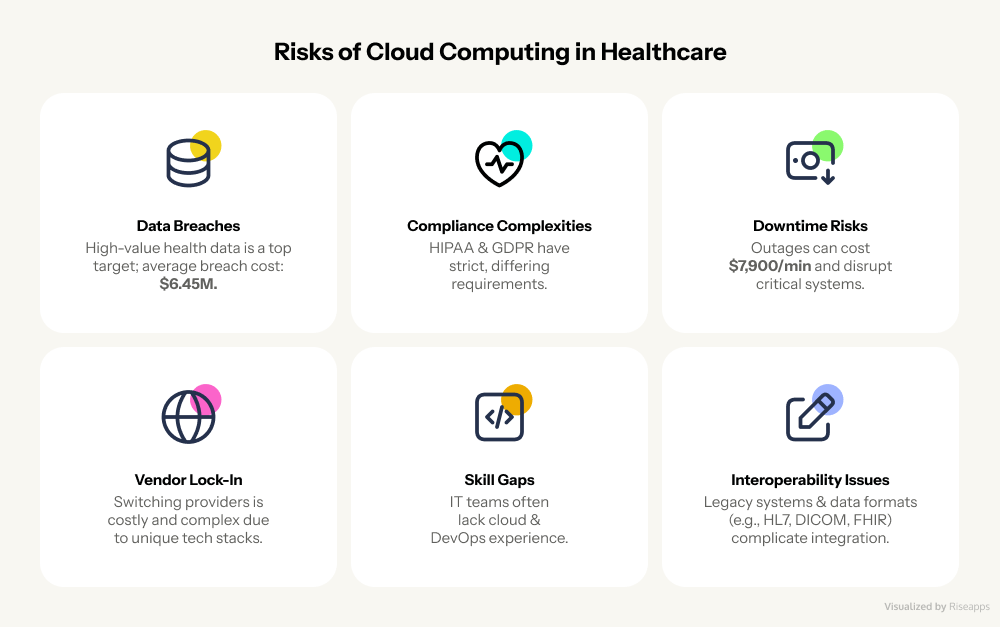
Security issues lead the pack of implementation challenges that determine if systems should move to cloud environments or stay on-premises.
Data Breaches and Unauthorized Access Risks
Healthcare IT leaders cite security concerns as their main reason for avoiding public cloud systems. Research shows that 71% of these leaders moved their cloud applications back to on-premises systems due to security concerns.
Their caution makes sense. Each breach costs organizations in the healthcare sector about USD 6.45 million, exceeding the USD 3.92 million average in other industries.
HIPAA and GDPR Compliance Complexities
Cloud systems in healthcare must follow strict regulatory frameworks. HIPAA requires covered entities to sign Business Associate Agreements with cloud computing providers and set up proper safeguards.
The GDPR rules demand breach notifications within 72 hours, while HIPAA allows 60 days. The GDPR lets patients request data deletion, but HIPAA forbids removing records.
Organizations need complete risk assessments to stay compliant, yet cloud service providers cannot obtain official HIPAA certifications.
Downtime and Service Availability Concerns
Real-time clinical applications (e.g., surgery and ICU monitors) may be sensitive to network latency. Healthcare organizations lose about USD 7900.00 each minute systems are down.
A recent example clearly shows these risks. Oracle Health engineers accidentally erased patient information during routine maintenance, causing a five-day outage across several Community Health Systems hospitals.
Reliance on internet connectivity means that connectivity loss can interrupt services.
Hospitals in remote or rural areas with limited bandwidth may face performance issues if key systems are cloud-hosted.
Edge cloud computing in healthcare can mitigate this, but hybrid solutions add architectural complexity.
Vendor Lock-in and Migration Limitations
Organizations often get stuck with one provider’s technology, making changes too expensive or technically impossible.
Each provider has unique services and APIs, so adopting a multi-cloud strategy is often recommended to reduce costs.
However, multi-cloud computing architectures require expertise to manage multiple platforms.
This problem surfaces when healthcare facilities try switching providers but cannot move their applications or data because resources and services differ between platforms.
Lack of In-house Cloud Computing Expertise
Healthcare organizations buy most applications instead of building them. This leaves system security largely up to the vendor’s design and maintenance.
Limited internal cloud knowledge worsens things, especially when medical devices run outdated software without vendor updates.
Healthcare IT teams must gain new skills in cloud computing management, security, and DevOps. The shift from traditional IT to cloud-based DevOps processes is non-trivial for many organizations.
System Interoperability
Integrating legacy on-premises systems with new cloud data management services can be complex.
Diverse data formats (HL7, DICOM, FHIR) and vendor lock-in of EHR systems may hinder seamless cloud integration.
Transitioning decades of medical records into a cloud data lake requires extensive ETL (extract-transform-load) efforts.
Moving data between clouds or between cloud and local systems can be time-consuming without industry-wide data standards.
7 Examples of Cloud Computing in Healthcare Applications
Healthcare organizations of all sizes now use cloud-based solutions to reshape patient care delivery.
Cloud computing in healthcare taps into remote servers, networks, and internet-based platforms to centralize patient records, run advanced analytics, and power day-to-day operations.
This model scales on demand, strengthens data security, and fosters real-time collaboration among clinicians and administrators.
Cloud-native automation streamlines everything from appointment scheduling to billing, freeing teams to focus on what matters most.
Electronic Medical Records (EMRs) on Cloud Platforms
Cloud-based EHR systems allow hospitals and clinics to store patient records centrally and provide clinicians access from anywhere.
Moreover, cloud-powered EMR systems give healthcare facilities substantial advantages over traditional on-premise solutions.
These platforms cut original capital costs and create predictable operating expenses through subscription models.
Instead of maintaining local servers for their EHR databases, providers can host EHR software (e.g., Epic, Cerner) on cloud infrastructure. Here are just a few examples of successful transitions.
- Mount Sinai Health System moved its large Epic EHR database to Microsoft Azure “Large Instances,” which are designed to run high-volume workloads. These instances can handle up to 50 million database accesses to scale with growth.
- Tufts Medicine implemented its EHR on AWS, which reduced technical debt and boosted security and resilience.
- Southeast Iowa Regional Medical Center set up AWS as a secondary site for its MEDITECH EHR; this cut its recovery time by 67% and ensured reliable continuity of care.
Many traditional EMR systems still work in isolation, creating compatibility issues. Cloud-based platforms help solve this by making data sharing easier between healthcare organizations.
Cloud-based Picture Archiving and Communication Systems (PACS)
PACS changed medical imaging by replacing film storage with digital options. Cloud-powered PACS take this progress further by keeping medical imaging data on secure off-site servers.
Cloud PACS advantages include:
- Digital access to current patient images and reports from any internet-connected location.
- No manual filing, retrieval, or transfer of sensitive medical information.
- Lower on-premises infrastructure costs through cloud-adjacent solutions.
- Better image access speeds and reliability throughout the imaging workflow.
Leading healthcare organizations have adopted cloud PACS solutions. Philips launched HealthSuite Imaging on Amazon Web Services to improve image access speeds and reliability while cutting hardware costs.
Medical Imaging and Analytics
Cloud computing in healthcare is widely used for storing and processing medical images (X‑rays, MRIs, CT scans). Large imaging files (hundreds of megabytes each) demand extensive storage. Moreover, advanced AI and imaging analytics often run in the cloud.
For example, at Rush University, cloud-based AI analyzes unstructured clinical data (including radiology images) to extract information hidden in doctor notes.
The scalability of the cloud solutions allows on-demand image reconstruction and GPU-powered machine learning.
Cloud image analysis can accelerate diagnoses (e.g. triaging urgent cases) and facilitate collaboration: radiologists can securely review images from anywhere.
Telehealth Platforms Using Cloud Computing Infrastructure
Cloud technology and telehealth together have changed how healthcare is delivered. Cloud-based telehealth platforms enable live consultations through video, voice, and text while meeting security requirements.
These systems include remote patient monitoring, secure data sharing, and teleconsultation features.
For instance, Teladoc Health, a leading telemedicine provider, relies on a cloud computing infrastructure to connect patients with physicians in real time.
Moreover, patient portals (web/mobile apps for viewing test results or messaging doctors) are often cloud-hosted for high availability.
Riseapps helped a maternal-fetal medicine telehealth company build a modern, efficient, and comprehensive partner portal to:
- enhance client satisfaction,
- reduce operational friction,
- secure their market position.
Within this single, cloud-based platform partners can schedule screenings or other services with just a few clicks, specifying patient details and preferred timeframes.
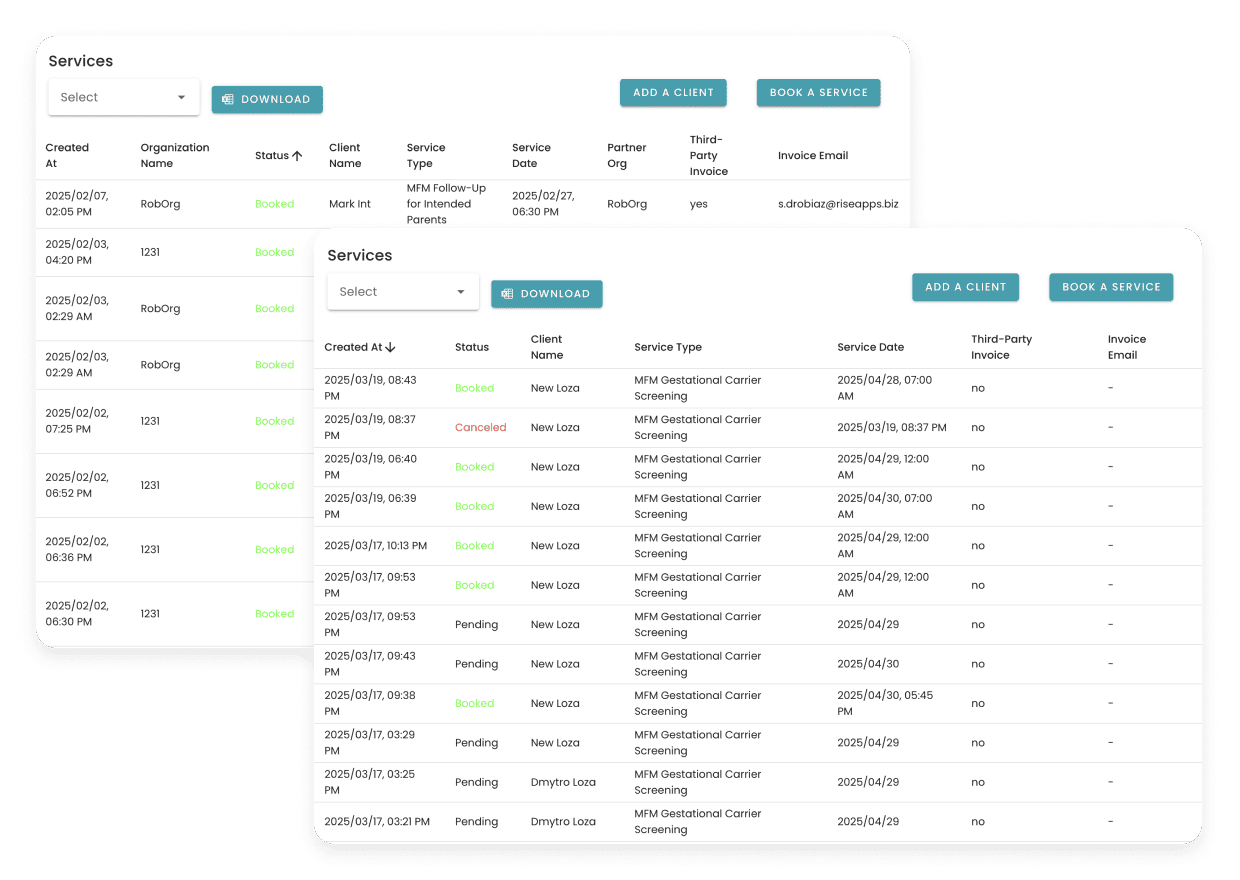
This portal includes a secure, HIPAA-compliant document repository that enables users to upload, download, and view the latest version of any file.
Want to know more? Read a complete case study on a partner portal for a fertility company.
The cloud-native design lets telehealth platforms grow individual parts separately. Critical services stay running during sudden usage spikes.
This adaptability proved valuable during COVID-19 when healthcare providers had to expand virtual care services quickly.
Genomic Data Analysis Using Cloud Computing
Genomic research creates massive datasets that regular computing systems struggle to handle. Cloud computing in healthcare provides specialized tools to store, analyze, and share genomic information.
AWS HealthOmics helps organizations store, query, and analyze genomic data at scale. Companies like Ancestry, AstraZeneca, and Genomics England utilize AWS to speed up research while reducing costs.
AstraZeneca’s genomics data processing solution runs 51 billion tests in just one day using cloud infrastructure.
Cloud computing platforms have become crucial for international genomics collaborations. Researchers can securely keep data in one place near computing resources.
This method allows scientists to reanalyze large sets of archived sequencing data. One study processed over 12,000 human cancer RNA sequencing datasets for just $0.09 per sample.
Wearable Health Devices Integrated with Cloud Storage
Wearable health technology combined with cloud computing creates effective systems for ongoing patient monitoring.
A wearable cardiovascular monitoring system for postpartum women connects to a cloud architecture for live waveform analytics.
The system’s mobile app works with the wearable device. It receives raw data and sends segments to a cloud-based computation engine.
Cloud computing infrastructure processes thousands of waveforms simultaneously to measure vital signs like heart rate, breathing rate, blood pressure, and oxygen levels in real time.
Another example is integration between wearables, cloud services, and a mobile platform in the fitness industry.
Our client in the athletic footwear industry partnered with us to merge advanced artificial intelligence (AI) with premium footwear design to enhance athletes’ performance, prevent injuries, and deliver personalized coaching.
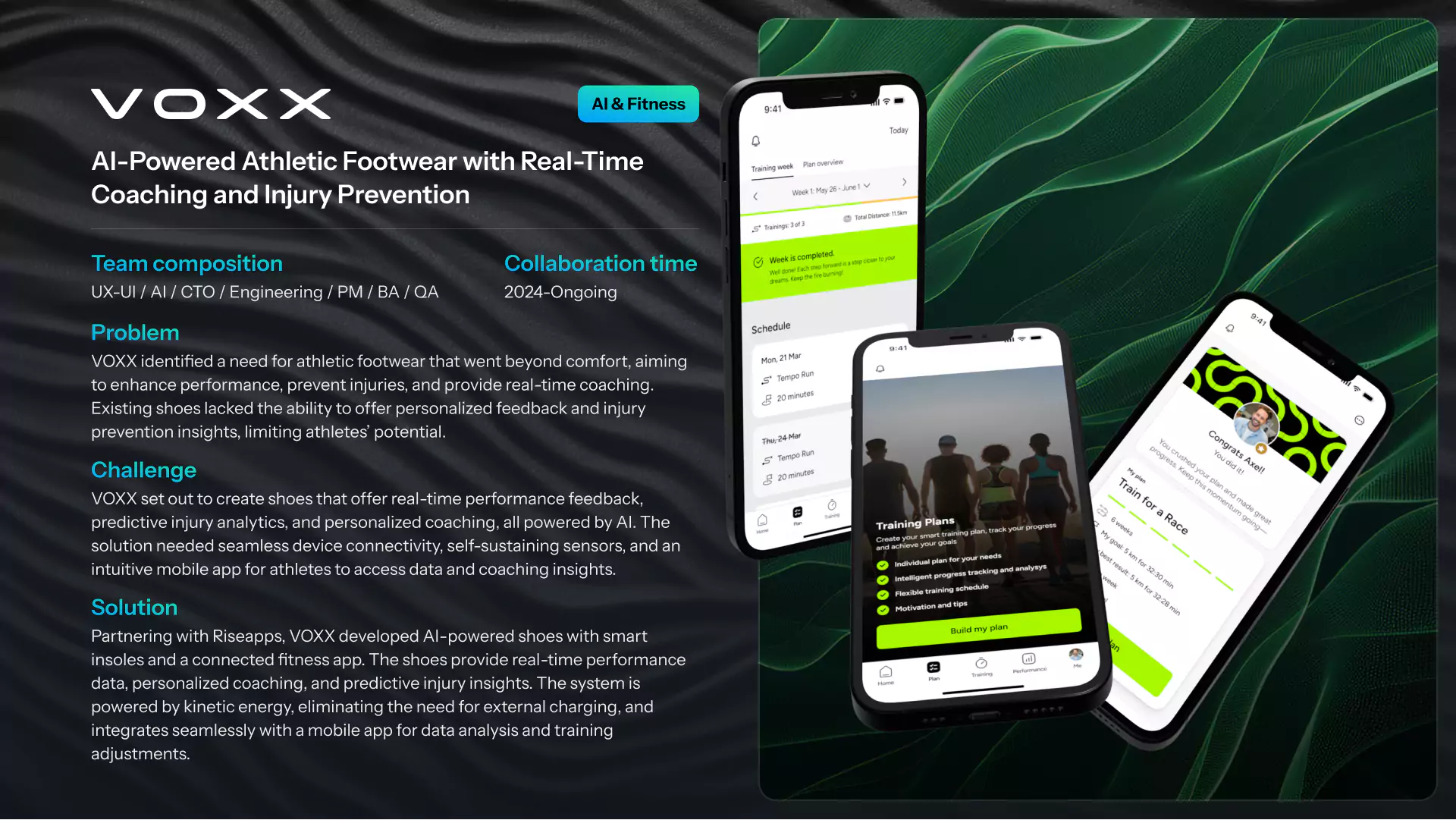
We’ve helped them embed specialized hardware into shoes via advanced sensor integration, develop a feature-rich mobile app on iOS/Android, and expand software capabilities with third-party services integration.
We’ll help you with fitness app development that meets your business goals, integrates with essential tools and APIs, and our team will ensure your app can gather, interpret and display data from wearable devices.
Big Data Analytics and AI for Care and Research
Cloud computing in healthcare provide the computational power for large-scale analytics and AI in healthcare.
Hospitals and research centers build data lakes in the cloud, aggregating EHR data, genomics, imaging, and social determinants. Machine learning models (for risk prediction, image recognition, etc.) are trained on these big datasets using cloud GPUs and clusters.
- IBM Watson Health, for example, uses cloud-based AI to analyze medical images and assist in detecting diseases like cancer.
- Rush University built a health‑equity analytics platform on AWS to mine social and health data and reduce life-expectancy gaps.
Thus, cloud computing in healthcare fuels predictive analytics, population health insights, and AI-driven diagnostics at scale.
Future of Cloud Computing in Healthcare and Emerging Trends
Cloud implementations in healthcare are changing faster than ever. These changes go beyond the reach and influence of simple storage solutions and create new ways to deliver care and analyze data.
Growth of Hybrid Cloud Computing Models in Hospitals
Healthcare providers choose this approach because it combines private infrastructure security with public cloud service flexibility.
Hybrid cloud computing adoption is accelerating. Hospitals can move workloads naturally between platforms as their IT needs change.
The hybrid model appeals to healthcare administrators because it cuts capital costs while retaining control over critical applications.
The model helps healthcare systems strengthen their protection against modern threats and improve their ability to recover from incidents that meet compliance rules.
Integration with AI for Predictive Analytics
Cloud computing in healthcare powers AI and leads to preventative, tailored healthcare models. Healthcare institutions now combine multiple datasets:
- genomic,
- economic,
- demographic,
- clinical information.
75% of health services companies plan to invest in artificial intelligence next year. This combination helps healthcare systems handle biological complexity beyond previous limits and changes disease management through evidence-based insights.
Gen AI-Powered Medicine Tools
Healthcare cloud computing market providers are rapidly adding AI services tailored to healthcare. For example, Google Cloud’s Gen App Builder (based on Large Language Models) has been piloted at Mayo to let clinicians query complex patient data using natural language.
As these AI-as-a-service offerings mature, we expect more cloud-based clinical decision support (e.g., smart summaries of patient notes, radiology report drafting), and virtual assistants. Integrating generative AI into EHRs and telehealth platforms is an active area of innovation.
Riseapps partnered with renowned podiatric surgeon Dr. Bill Releford to launch the Black Doctor 24/7 app and create Amina, a clinically tested virtual AI assistant powered by Infermedica’s health assessment engine.

Amina AI assistant provides intelligent symptom triage, guiding patients through initial healthcare interactions and speeding up the diagnostic process by 65%.
Federated Learning and Privacy-Preserving AI
Privacy remains paramount for healthcare professionals. Federated learning is an emerging approach where artificial intelligence models are trained across multiple institutions without sharing raw healthcare data.
Cloud collaborations are adopting this: Mayo Clinic’s partnership with Google (Mayo Clinic Platform) explicitly uses a “data under glass” model – data stays on Mayo’s cloud and algorithms come in under strict controls, enabling multi-center AI research while protecting privacy.
This trend allows cross-institutional learning (improving AI accuracy) without violating HIPAA. Cloud-based enclaves and distributed training frameworks are being developed to support federated models in healthcare.
Expansion of Cloud-based Genomics and Bioinformatics
Next-generation sequencing healthcare data creates enormous computational challenges that cloud computing solves. Genomic data volumes keep growing worldwide as sequencing becomes cheaper.
Amazon Web Services, Google Cloud, and Microsoft Azure have become crucial for bioinformatics researchers who handle massive computational tasks.
These platforms use specialized tools like NoSQL databases to store and analyze large genomic datasets efficiently.
Data Lakes and Population Health Analytics
Healthcare organizations are building large cloud-based data repositories that combine clinical, genomic, and socio-economic data for analytics.
Such data lakes allow advanced population health management and precision medicine.
For instance, AWS and Azure now offer healthcare data lake services where billions of records can be securely stored and queried.
In research, pharmaceutical companies like Gilead and Moderna are using cloud data meshes to accelerate drug discovery.
Cloud-scale analytics also power initiatives like disease surveillance, predictive modeling for epidemics, and large-scale clinical trials.
Blockchain and Data Integrity
Some healthcare organizations are experimenting with blockchain technology on the cloud to secure transaction records and trace data provenance.
A tamper-proof ledger on a cloud infrastructure can help track medication supply chains or patient-consent logs.
Although still exploratory, cloud-hosted blockchain services promise immutable audit trails for shared sensitive patient data, improving trust and compliance.
How Risapps Can Help You Adopt Cloud Computing Technology
Cloud is changing healthcare, enabling instant access to data storage, secure collaboration, and scalable services from telemedicine to AI-powered diagnostics.
But to unlock its full potential, you need deep domain knowledge, rigorous compliance, and the proper technical framework. That’s where Riseapps comes in.
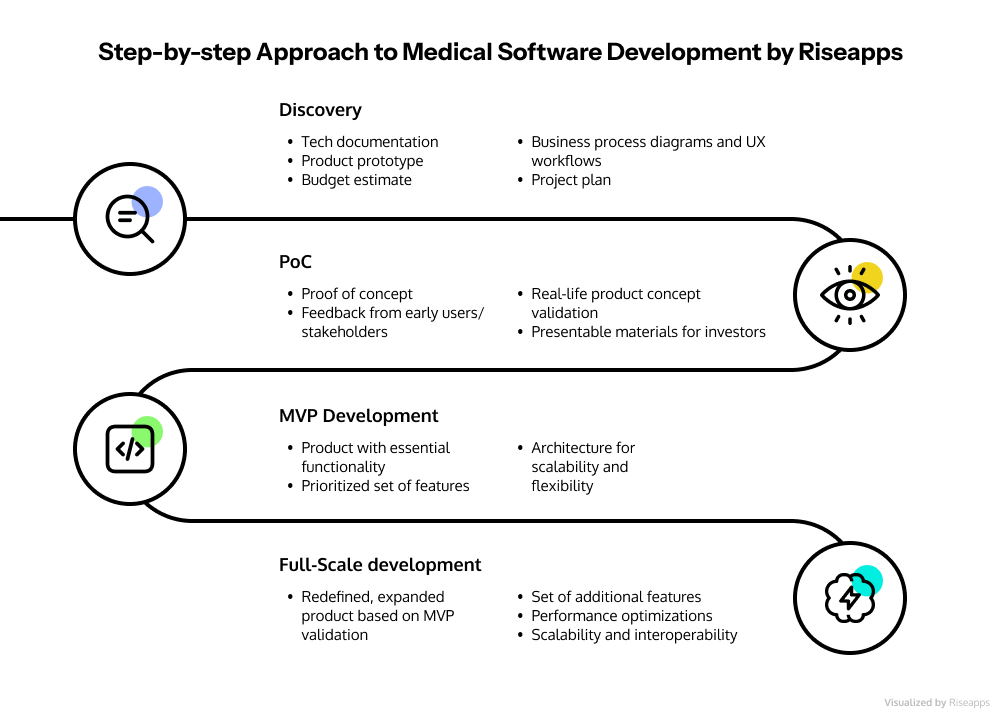
At Riseapps, we tailor our cloud-based software development services to meet the specific needs of healthcare facilities.
Broad expertise
Our extensive development expertise spans a broad range of healthcare solutions, including:
- telemedicine platforms,
- patient portals,
- AI-driven diagnostics.
Our team takes the time to thoroughly understand your internal business processes, crafting customized development plans that align with your goals.
Tailored services
To provide maximum value, we offer various services to guide you through every stage of your product journey.
- The AI consulting session is a free 30-minute call with our CTO to answer all your questions about architecture, development flows, and selecting the right tech stack.
- With comprehensive planning during our project discovery phase, we’ll deliver a robust blueprint for your project in just two weeks, starting at $10,000.
- If you want to validate ideas or refine your product, our AI product workshop clarifies target audience segments and a tailored roadmap for your MVP, all for just $3,000.
Incremental development
- We offer Proof of Concept (PoC) development in just 14 days starting at $10,000+, enabling you to validate your market and pitch to investors.
- Our MVP development service delivers responsive cloud solutions with a SuperAdmin panel and user profiles. It starts at $45,000 and is ready within 60 days.
- Unlock expert leadership with CTO-as-a-Service, starting at $12,000/month, which includes in-depth audits, recruitment strategies, and risk management plans to ensure your tech infrastructure is future-proof.
Proven track record in custom healthcare software development
Choosing Riseapps means partnering with a company that combines deep healthcare industry knowledge with cutting-edge technical expertise.
Riseapps has a proven track record of delivering impactful healthcare solutions that drive significant results for providers and patients.
- Our AI-powered medical summarization platform has achieved a 40-fold increase in summarization speed, operates at one-third the cost of traditional methods, and has an accuracy rate of 85%.
- Development of the BlackDoctor 24/7 platform enabled screenings for 30,000 underserved African American patients to be completed in just two weeks, ensuring timely access to care.
- Our collaboration with Almond Health led to the booking of 462 new appointments for OB-GYN patient care in one month and the raising of $7 million in funding, demonstrating our ability to deliver solutions that drive both patient engagement and business growth.
Whether you’re streamlining physician workflows, enhancing patient outcomes, or embedding AI diagnostics, Riseapps has the experience and dedication to bring your vision to life—on time, on budget, and at the forefront of healthcare innovation.
FAQ
What is the biggest concern with cloud computing in healthcare?
The primary concern is protecting sensitive patient data—ensuring robust encryption, strict access controls, and ongoing HIPAA/GDPR compliance. Any security lapse, misconfiguration, or unauthorized access can lead to data breaches, legal penalties, and loss of patient trust.
What are advantages and disadvantages of cloud computing in healthcare?
Advantages include on-demand scalability, cost-effectiveness, advanced analytics, improved collaboration and real-time access to patient data. Disadvantages involve security and privacy risks, regulatory compliance burdens, potential service outages and vendor lock-in, affecting continuity and control.
What is the most used cloud platform in healthcare?
Amazon Web Services (AWS) leads healthcare cloud adoption thanks to its mature HIPAA-compliant services and vast partner ecosystem. It’s followed closely by Microsoft Azure and Google Cloud Platform, both offering robust compliance, scalability, and advanced analytics capabilities.
What are the five main uses of cloud computing?
Organizations leverage cloud computing for on-demand infrastructure provisioning (IaaS), managed development platforms (PaaS), software-as-a-service delivery, scalable data storage and backup, and robust disaster-recovery solutions—enabling cost savings, agility, and high availability.
How is cloud computing used in healthcare?
Cloud computing in healthcare powers scalable EHR storage, telemedicine platforms, remote patient monitoring, and AI-driven analytics. It enables real-time collaboration among providers, secure data sharing, automated backups, disaster recovery, and seamless integration with medical devices.
Contact Us



